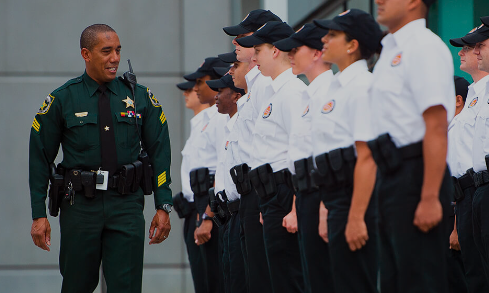
Public safety officers, often referred to as law enforcement officers, firefighters, and emergency medical personnel, play a pivotal role in safeguarding communities, responding to emergencies, and upholding public order. These dedicated professionals form the backbone of public safety, ensuring that citizens can live their lives with a sense of security. In this comprehensive exploration, we delve into the multifaceted world of public safety officers, covering their roles, responsibilities, training, challenges, and the crucial role they play in maintaining the well-being of societies.
Introduction to Public Safety Officers
1 Defining Public Safety Officers
Public safety officers encompass a diverse group of professionals who are entrusted with the responsibility of ensuring the safety and security of the public. This includes law enforcement officers, firefighters, emergency medical personnel, and other first responders.
2 The Scope of Public Safety
The scope of public safety extends beyond crime prevention to include responding to medical emergencies, natural disasters, fires, and other incidents that pose a threat to public well-being. Public safety officers are trained to handle a wide range of situations, making them versatile and indispensable contributors to community resilience.
Roles and Responsibilities of Public Safety Officers
1 Law Enforcement Officers
1 Crime Prevention and Investigation
Law enforcement officers are responsible for preventing and investigating criminal activities. They patrol neighborhoods, respond to emergency calls, and gather evidence to solve crimes.
2 Public Order Maintenance
Maintaining public order is a crucial aspect of law enforcement. Officers ensure that public spaces are safe and that individuals can go about their daily activities without fear.
3 Community Engagement
Building positive relationships with the community is an essential part of a law enforcement officer’s role. Community engagement fosters trust and collaboration between officers and the people they serve.
2 Firefighters
1 Fire Prevention and Suppression
Firefighters focus on preventing fires through education and inspections. When fires do occur, they are the first responders, working to suppress the flames, rescue individuals, and mitigate property damage.
2 Emergency Medical Response
Firefighters often serve as emergency medical technicians (EMTs) or paramedics, providing vital medical assistance in emergencies. They respond to accidents, medical crises, and other incidents requiring immediate medical attention.
3 Hazardous Material Response
In addition to fires, firefighters are trained to handle hazardous materials incidents, such as chemical spills or leaks, to protect both the public and the environment.
3 Emergency Medical Personnel
1 Pre-hospital Emergency Care
Emergency medical personnel, including paramedics and EMTs, provide pre-hospital emergency care. They respond to medical emergencies, administer life-saving interventions, and transport patients to medical facilities.
2 Trauma Care and Critical Interventions
These professionals are trained to provide trauma care, including managing injuries from accidents or violence. They also perform critical interventions such as cardiopulmonary resuscitation (CPR) and administering medications.
3 Collaborative Response
Emergency medical personnel work closely with law enforcement officers and firefighters to ensure a coordinated and efficient response to emergencies. Collaboration is essential for optimal patient outcomes.
Training and Education for Public Safety Officers
1 Law Enforcement Training
1 Police Academies
Law enforcement officers typically undergo training at police academies, where they learn about criminal law, investigative techniques, self-defense, and community relations.
2 Ongoing Professional Development
Continual training is crucial for law enforcement officers to stay updated on changes in laws, emerging technologies, and best practices. This includes firearms training, crisis intervention, and cultural competency.
2 Firefighter Training
1 Fire Academy
Firefighters attend fire academies, where they receive training in fire suppression, rescue operations, hazardous materials response, and emergency medical care.
2 Specialized Certifications
Many firefighters pursue specialized certifications, such as technical rescue or wildfire fighting, to enhance their skills in specific areas.
3 Emergency Medical Personnel Education
1 EMT and Paramedic Programs
Emergency medical personnel undergo EMT and paramedic training programs, where they learn anatomy, physiology, medical procedures, and patient assessment.
2 Continuing Education
To maintain certification, emergency medical personnel participate in ongoing education to stay informed about advancements in medical treatments and protocols.
Skills Required for Public Safety Officers
1 Critical Thinking and Problem-Solving
Public safety officers must think critically and make rapid decisions in high-pressure situations. The ability to assess complex situations and devise effective solutions is crucial.
2 Communication Skills
Effective communication is paramount for public safety officers. They must communicate clearly with colleagues, the public, and other emergency responders to ensure a coordinated and efficient response.
3 Physical Fitness
Physical fitness is a foundational requirement for public safety officers. They need strength, endurance, and agility to perform tasks such as rescues, firefighting, and pursuing suspects.
4 Compassion and Empathy
Public safety officers often encounter individuals in distress or crisis. Compassion and empathy are essential for providing comfort and support in these situations.
5 Teamwork and Collaboration
Collaboration is inherent to public safety. Officers must work seamlessly with colleagues from different disciplines to address multifaceted emergencies.
Challenges Faced by Public Safety Officers
1 Mental Health Strain
Public safety officers often face stressful and traumatic situations, leading to mental health challenges. The cumulative impact of exposure to emergencies and critical incidents can result in conditions such as post-traumatic stress disorder (PTSD).
2 Public Perception and Trust
Public safety officers may encounter challenges related to public perception and trust. Building and maintaining positive relationships with the community is crucial for effective policing and emergency response.
3 Budgetary Constraints
Government budgets can impact the resources available to public safety agencies. Adequate funding is essential for training, equipment, and staffing to ensure optimal public safety.
4 Risks to Personal Safety
Public safety officers face inherent risks to their personal safety. From confronting armed individuals to entering burning buildings, the nature of their work exposes them to potential harm.
5 Legal and Ethical Dilemmas
Navigating legal and ethical dilemmas is a constant challenge for public safety officers. Balancing the protection of public safety with respect for individual rights requires careful consideration and adherence to legal standards.
Evolving Trends in Public Safety
Technology Integration
The integration of technology is transforming public safety. Body-worn cameras, drones, predictive analytics, and communication tools enhance the capabilities of public safety officers.
2 Community Policing
Community policing emphasizes building strong relationships between law enforcement and the communities they serve. This approach fosters collaboration and shared responsibility for public safety.
3 Mental Health Awareness
There is a growing recognition of the mental health challenges faced by public safety officers. Initiatives focusing on mental health awareness, support, and counseling are becoming more prevalent.
4 Data-Driven Decision-Making
Public safety agencies increasingly use data to inform decision-making. Data analytics help identify patterns, allocate resources efficiently, and enhance overall strategic planning.
5 Disaster Preparedness and Resilience
In the face of increasing natural disasters and emergencies, public safety agencies are placing greater emphasis on disaster preparedness and community resilience. Training and coordination efforts are critical components.
Future Prospects for Public Safety Officers
1 Artificial Intelligence and Robotics
The future of public safety may involve the use of artificial intelligence and robotics for tasks such as predictive policing, surveillance, and search and rescue operations.
2 Cybersecurity and Digital Crimes
As technology advances, public safety officers will need to focus on cybersecurity and combating digital crimes. This includes addressing cyber threats, online fraud, and protecting critical infrastructure.
3 Public Health Preparedness
Recent global events, such as the COVID-19 pandemic, highlight the importance of public health preparedness. Public safety officers may play a key role in coordinating responses to public health emergencies.
4 Training and Education Reforms
Continual improvements in training and education are likely to be a focus in the future. This includes enhanced cultural competency training, de-escalation techniques, and advanced medical training for first responders.
5 International Collaboration
Global challenges, including terrorism and transnational crime, may lead to increased international collaboration among public safety agencies. Sharing intelligence and resources will be crucial for addressing cross-border threats.
Conclusion
Public safety officers stand as the frontline guardians of community well-being, facing myriad challenges with unwavering dedication. Whether responding to emergencies, maintaining public order, or preventing crimes, these professionals play an indispensable role in the fabric of society. The demands of their professions require a unique set of skills, from critical thinking to physical fitness, and the ability to navigate complex legal and ethical landscapes.
As public safety evolves in response to technological advancements, societal changes, and global challenges, the role of public safety officers will continue to expand. Embracing new technologies, fostering community partnerships, and prioritizing mental health awareness are integral components of this evolution. The future prospects for public safety officers involve not only addressing emerging threats but also advancing the principles of justice, compassion, and service to humanity.
In celebrating the contributions of public safety officers, it is essential to recognize the sacrifices they make and the impact they have on the safety and security of communities. The journey of a public safety officer involves not only professional duty but a profound commitment to the welfare of the individuals they serve. As societies navigate the complexities of the modern world, the role of public safety officers remains pivotal in shaping resilient, secure, and harmonious communities.







